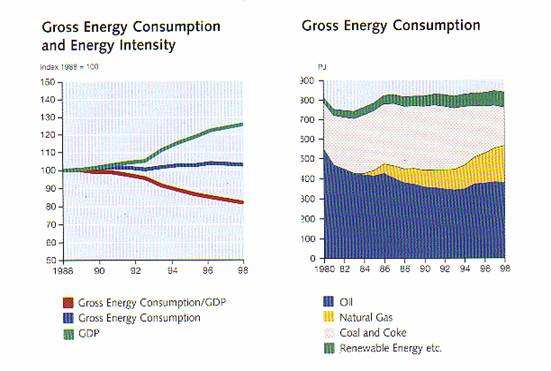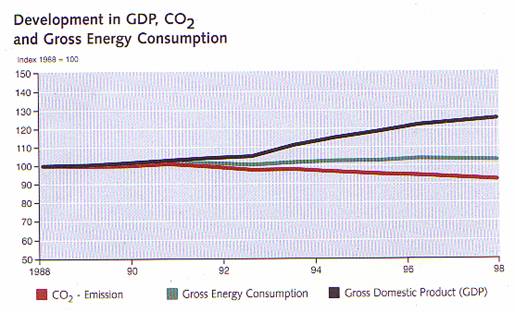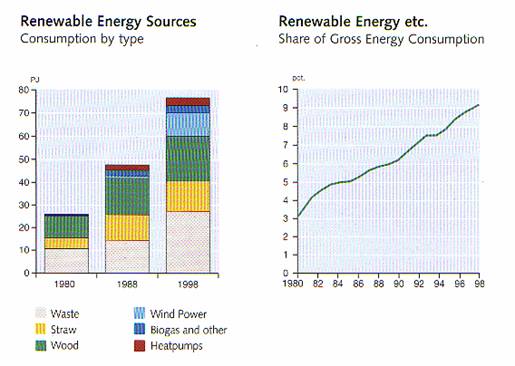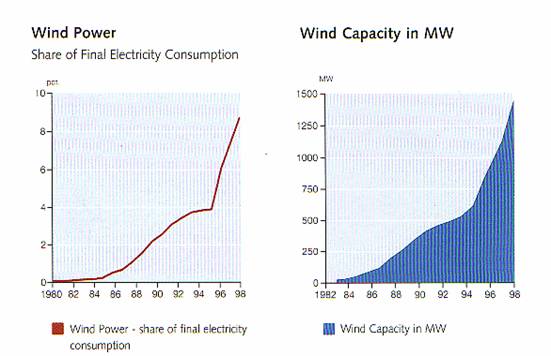[Denmark]
Introduction, Energy Policy 1990-2001
![]()
Danish Energy Policy
Denmark has a long history of energy policy. The reasons for which stem
from the countries lack of natural energy sources and the effects of not
only the World Wars but also the oil crisis of the 1970's. Around the turn
of the 20th century, Denmark found itself in a position where it had to
import fossil fuels for power generation, and had no significant
possibilities for the utilisation of Hydro Power. This meant that if they
were to satisfy there own energy needs then other forms of production
would have to be developed. This led the Government at the time to fund
research into renewable forms of energy, in particular wind energy, which
resulted in Poul la Cour and a team of scientists building a test windmill
as early as 1891.
The First World War caused a shortage of imported fossil fuels and the
initial work almost 20 years previously resulted in "a quarter of all
Danish rural power stations was using wind turbines for power generation"
. World War Two had the same effect and again renewed interest in
renewables, mainly wind, was generated. In 1950, The Association of Danish
Electricity Utilities examined the possibilities of incorporating Wind
Power within the Danish Power System. J. Juul, a Danish engineer designed
the 200kW Gedser machine that was installed in 1957. This turbine stood
the test of time and when data was required for a measurement programme in
1977, the refurbished Gedser turbine was used.
The oil crisis of the 1970's combined with growing world wide environmental concerns led to a resurgence of interest in renewable energy. The drastic increase in Oil prices at these times led to all dependent countries realising they needed a diverse and assured energy supply. Denmark looked to explore oil and gas in its North Sea territory and also identified renewable energy, energy efficiency, energy saving, and reduced consumption as important steps towards a greener and more secure energy supply. The first national energy plan was adopted in 1976, and further development occurred in the 1980's. This restructured the energy system and led to the total primary energy consumption being virtually stagnant despite a growing economy.
The following is an introduction to the methods deployed in Denmark since 1990. The aim of this is to display which instruments were successful and contributed to the growth of renewable energy. The Danish Government has recently been replaced and due to problems with supply and demand the support for renewable energy projects has been halted prior to further investigation. This report will not deal with the reasons for this, only the ways in which renewables were encouraged and deployed and not the faults that led to the current state of affairs.
The policy "Energy 2000" was introduced in 1990 to establish
the goal of sustainable development in the energy sector. The aim of this
policy and its characteristics are consistent with "Energy 21"
which was introduced later, in 1996. The main overall target of these
policies was to reduce CO2 emissions in 2005 by 20% in comparison to 1988
levels. There is a subordinate target for the transport sector to reduce
its CO2 emissions to the 1988 level, meaning that other sectors must reduce
by 25% to ensure the overall target is met. The main sources of CO2 emissions
were power plants and transport, accounting for 50% and 20% respectively
at 1994 levels . Renewable energy therefore had a large part to play in
the forthcoming years to help reduce the CO2 levels. These policies therefore
also incorporated the goal of the share of renewable energy to grow to
12-14% of energy supply within this time period.
Initially, energy taxes were introduced on fossil fuels and electricity
mainly in the household sector. As seen in figure one, this caused the
consumption of oil to reduce for the first few years of the 1990's, and
stagnated the use of fossil fuels. This also worked to increase the share
of renewable energy and the gross energy consumption remained constant
at around the 1988 level.

Figure One: Gross Energy Consumption and Energy Intensity (sourced: "Energy
in Denmark: Development, Policies and Results" 2000
In 1992, there was a taxation reform and the previous system was replaced
with a combined energy and CO2 tax, renewable energy was exempt from this
tax. Subsidies were introduced for environmentally friendly forms of electricity
production; this was an important step in expanding the use of renewables.
This helped to reduce CO2 emissions and also generate increased consumption
of renewable energy sources, as can be seen in figures two and three.

Figure Two: Development in GDP, CO2 and Gross Energy Consumption (sourced:
"Energy in Denmark: Development, Policies and Results" 2000

Figure Three: Renewable Energy sources- Consumption by type, share of
gross energy consumption (sourced: "Energy in Denmark: Development,
Policies and Results" 2000
In 1993, the government performed an analysis resulting in the "Follow
up on Energy 2000". This showed that the CO2 targets that had been
outlined previously would not be attained by several million tonnes, in
relation to the target of a 20% reduction by 2005. Reactionary measures
were then introduced to ensure that these targets were still in sight.
Green Taxes became more widely used in all sectors of the economy, for
example; energy, CO2, water, waste etc. The "Biomass Agreement"
of 1993 was a political agreement within Denmark that the use of biomass
should increase considerably prior to the end of the year 2000. This was
to be supported by converting the large power plant units to biomass-based
production. The goal of the agreement was for the plants to use 1.4 million
tonnes of straw and chips for electricity generation and district heating
production by the year 2000.
1995 saw the introduction of the "Green Tax Package" for trade
and industry. This was an effort to make energy consumption more efficient
in this sector. The package was based on annual tax increases for trade
and industry. These taxes came with an agreement scheme for those who
are energy intensive, and also were recycled in the form of subsidies
for energy saving, and reductions in the taxation of labour. This encouraged
Industry and companies to look towards not only energy consumption and
efficiency but also renewable energy as a means of meeting their needs,
leading to an economic gain. Two pieces of legislation came from The Development
Programme for Renewable Energy (DPRE) in this year that are very important
as they look not to the large scale but to small scale applications and
off-setting generation. These were the "Promotion of solar cell systems"
and to "Promote expansion of household wind turbines". The Solar
initiative was introduced under the green tax package for trade and industry
as well as the DPRE; both initiatives used subsidies to encourage the
development of the technologies using demonstration projects and small-scale
installations. This makes the development of the technologies much more
economically viable.

Figure Four: Wind Power and Wind Capacity (sourced: "Energy in Denmark:
Development, Policies and Results" 2000
In 1996 the Danish Government introduced its second major all encompassing
Energy Policy of the 1990's entitled "Energy 21". The main purpose
of this policy was to promote energy savings, expansion of CHP and increase
the use of renewable energy. This all with the same goal for emissions
from Energy 2000, to reduce its CO2 emissions to the 1988 level and for
renewable energy to grow to 12-14% of energy supply within this time period.
The policy introduced some new initiatives with respect to renewable energy
to try and facilitate reaching these targets. Three such schemes that
served to increase the share of renewables were the "Land based wind
order", " Offshore wind order" and the "Renewable
Energy Island project". Energy 21 outlined the expansion of on and
offshore wind power to be 1500MW in 2005, corresponding to a total production
of 3.2TWh annually. As of the end of 1998, this target was almost reached;
1467 MW wind power had been installed . This legislative instrument therefore
appears to have been successful, as was illustrated previously in figure
four; the increase in the use of wind power is clearly visible. Another
legislative instrument to aid renewable energy was the "Construction
stop for coal-fired power stations" which provoked interest in renewables
from the electricity sector that had previously been involved with coal
fired generation. Energy 21 also included many other legislative instruments
to help renewable energy become economically feasible; these can be researched
from http://www.ens.dk
. The Renewable energy island project was a subsidised project
to demonstrate the economic/technical/organisational conversion of an
entire community to 100% renewable energy supply. This led to the Island
of Samso being selected at the end of 1997; the aim was to achieve 100%
conversion by 2008. This creates awareness of the capabilities of renewable
energy and brings it to the attention of the general public.
The Kyoto agreement in 1997 was an important international step against
global warming and also recognising that measures, such as renewable energy,
are a necessity to provide environmentally sound methods of energy production.
Also in this year, the EU directive on the liberalisation of electricity
became effective, and more recently the EU Directive on the promotion
of electricity from renewable energy sources in the internal electricity
market. These pieces of legislation were to shape Danish energy policy
over the next few years.
The Kyoto agreement led to Denmark aiming to reduce greenhouse gas emissions
by an average of 21% in relation to 1990 levels, between 2008-2012. This
fitted in with the current national targets that were mainly established
around reducing CO2 emissions, as CO2 is the dominant greenhouse gas.
In 1998 the share of renewables had not grown sufficiently to be on track
for meeting targets set out previously, this was mainly due to the slower
development of biomass-based CHP. Measures were necessary to achieve the
targets, energy tax rates were increased but the country was moving in
a different direction in 1999; inspired by, among other things, the EU
moving towards the liberalisation of the electricity market and the establishment
of a green certificate system.
The Electricity Reform of 1999 took place with the goal of setting up
an internal green market. This was a political agreement amongst all the
parties in Denmark. Part of this was the obligation of the consumer to
ensure that 20% of their energy consumption came from renewable energy
sources. This purchase obligation was to form the basis for the market
and to ensure a stable demand for renewable energy and stimulate its growth.
Green Certificates are awarded to generation companies per MWh produced
and then these can be sold on the green market. The certificate will exist
only in electronic form in the green certificate register with information
concerning the time of issue, origin, technology etc. The market does
not distinguish between technologies and therefore this could cause problems
for less developed technologies that are not as economically feasible
as say wind. But as the certificate contains technology information it
would allow consumers to target specific areas. The consumer is protected
against the market establishing a higher price from renewable energy than
is currently found, and has the option of paying a fixed fine instead
of complying with their purchase obligation. The establishment of this
market was expected to increase the share of renewable energy to approximately
27% in 2003, therefore already surpassing the targets set out previously.
Also, in the year 2000 it was found that CO2 levels had fallen 11% and
if the current path were continued then targets would be met. The EU approved
the Green Market in 2000, the same year that the EU directive on the Promotion
of Electricity from Renewable Energy Sources was published which recognised
that a Market based on certification would help to harness renewable energy
and increase its share.
The government introduced "Climate 2012" in 2000, this being
the first step towards a comprehensive climate strategy. The progress
in 2000 was mainly due to political agreement on the implementation of
the Biomass Agreement and also for offshore wind. The Biomass Agreement
of 2000 establishes supplementary firing of straw and wood chips at plants
throughout Denmark. These arrangements are made with a view towards burning
150,000 tons of straw by the end of 2004. The offshore wind farm order
in this same year established a concrete basis for fixing the settlement
prices making it possible for offshore to be as economically feasible
as onshore wind. The main purpose of this policy is to form the basis
for future decisions on climate change policies in Denmark, in doing this
is undertook a study that predicts a deficit of 4.4% from the target for
emissions reduction.
In conclusion, it can be said that Danish Energy policy has proved effective
in developing renewable energy and allowing it to be economically competitive
with traditional forms of power generation. This growth has not affected
the total gross energy consumption, which has remained almost constant,
despite a growing economy, due to among other things, the efforts to increase
energy efficiency in energy supply. The policy has changed over the years
in response to the different Global and European circumstances. The establishment
of a Green Market is potentially a crucial step towards inclusion in a
European Union internal single market. How the country approaches Energy
Policy now that a different Government is in power is to be seen, although
it is worth noting that the Electricity Reform of 1999 was a political
agreement between all parties.
![]()
Policy, UK, USA, Denmark presentation
![]()